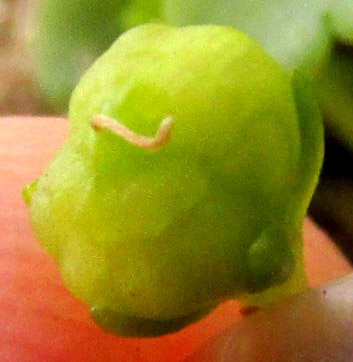Excerpts from Jim Conrad's
Naturalist Newsletter
entry dated May 19, 2022, notes from a camping trip among hills about 7kms ENE of Tequisquiapan, Querétaro state, MÉXICO
elevation about 2040m (6700 ft), near N20.57°, W99.85°
KENILWORTH IVY IN A GROTTO
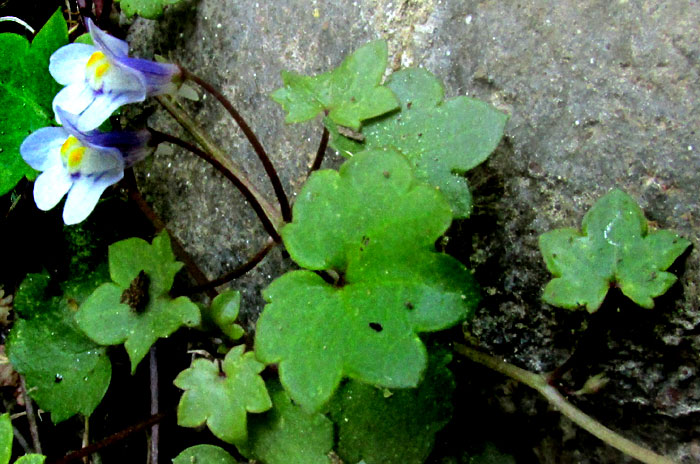
On the northern edge of the two-small-blocks-across, hillcrest village of La Higuera, at the base of a tall, vertical rock cliff, there's a wonderful grotto where big ash and baldcypress trees provide blessedly cool, moist shade in the otherwise scrubby, parched-dry landscape. Years ago a shoulder-high stone containment wall was built to pool water below a perpetually flowing little stream issuing through a pipe stuck in the rock, always creating a friendly sounding dribbling sound. Of course at one side there's an altar adorned with faded plastic flowers dedicated to the Virgin. Across the pool of cold water, the bare stone wall is adorned here and there with dark mosses and ferns. At the grotto's edge, where there's more light and it's drier, the little wildflower shown above may greet you, if you're paying attention to the smaller things.
The corollas are only about 12mm long (½ inch), and since they arise from amid a mass of slender, branched stems that creep along the cliff's wall, rooting in cracks, they might be missed.
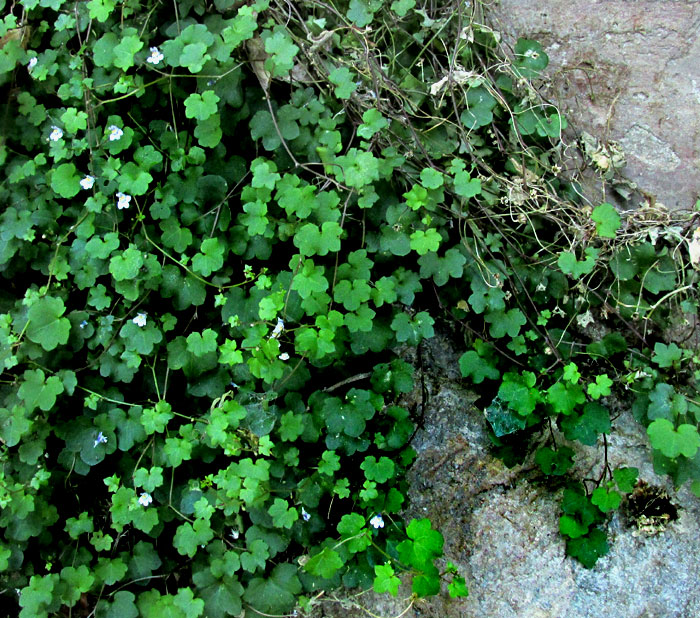
However, if you look closely at the blossoms, you see interesting details:
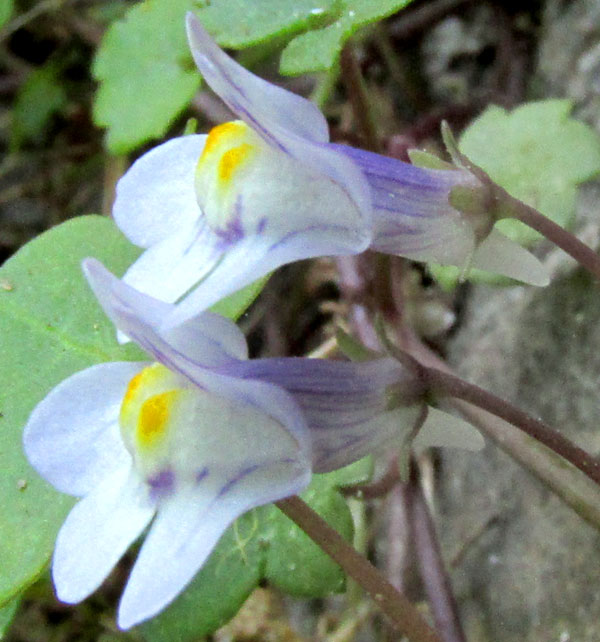
To their bee pollinators they must look very inviting, their pale faces showing so intensely against the dark greenness behind them. And as the bees approach, two yellow beacons show exactly where to enter, and below the beacons two petals jut outward providing a landing pad. Dark lines on the corolla further direct the bee's attention into the corolla's throat.
But, after all those invitations, once the pollinator is committed to entering the chamber of sweet delight, the corolla is prepared to tease its visitors. In the above photo, did you notice the "spur," the corolla's talon-like projection pointing backwards? That's where the nectar is. The bee must reach deep to gain her reward, both daubing her load of pollen from other flowers onto this flower's stigma, and in turn being daubed with pollen from this flower's four stamens, as she reaches into the nectar spur.
With all these details of flower in mind, already we think we know which plant family this is, but just in case the pretty plant is as tricky with its identifiers as with its pollinators, it's good to pay attention to the leaves, too:
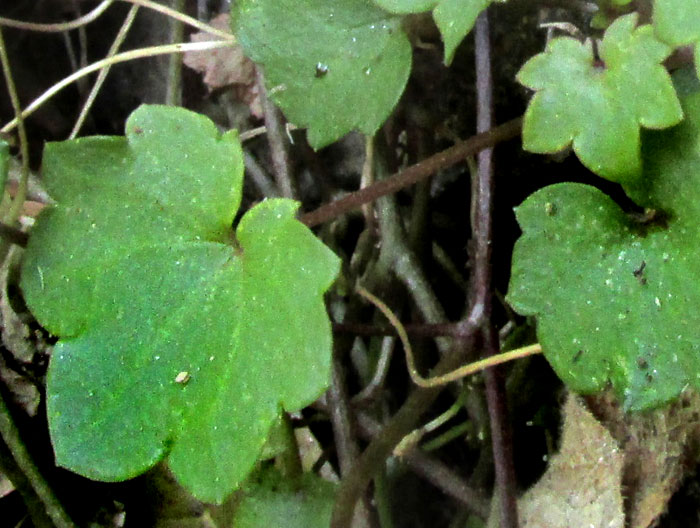
Ivy-like leaves on long, running stems running amid a tangle of thin, white roots probing for places to take hold...
And, speaking of probing, later I learn something special about the flowers: When the flower needs to be pollinated, it faces light, but once it's pollinated and the seeds are maturing, the stalk, or pedicle, bends around, pointing the developing fruit toward darkness. The idea is that when the capsule-type fruit is ready to shed seeds, the seeds are more likely to be pushed into a dark crevice with soil and moisture in which to germinate, than where there's light. Also, the plant doesn't really need to be pollinated, for it's capable of self fertilization.
This is CYMBALARIA MURALIS, with a host of English names, but nowadays the name that pops up most is that of Kenilworth Ivy. But also there's Ivy-leaved Toadflax, Coliseum Ivy, Oxford Ivy, Mother of Thousands, Pennywort, Wandering Sailor, take your pick. It's native of southern and southwestern Europe, but as a weed it has spread throughout the world.
However, it's a particularly pretty and useful weed. The leaves have been documented being used in salads, but having an acrid, pungent taste that really isn't so good, though in an emergency it might do. A yellow dye can be obtained from the flowers, though it doesn't stay where it's put very well. Poultices have been made of its leaves to place on flesh wounds to stop bleeding, and in India it's been reported as useful in treating diabetes.
Anyway, identifying this plant did turn out to be tricky. When I tried to confirm my strong suspicion that any plant with a corolla shaped like that, especially with those yellow humps at the mouth and with such nectar spurs projecting out behind, had to be a member of the Snapdragon Family, the Scrophulariaceae, I couldn't do it. When I looked into the Snapdragon Family in all the usual online floras, it simply wasn't there.
An entire morning was spent exhausting all possibilities in the Snapdragon Family of Mexico, the US, China and Pakistan, and then I looked into all the closely related families, and our plant wasn't there, either.
Eventually, thinking I might halfway remember the plant or one much like it from my days of botanizing in the Alps, at an outdated website in Germany providing pictures of German wildflowers grouped according to corolla color, on the blaublühend page I found our Kenilworth Ivy. Looking up the binomial, I learned that nowadays, thanks to gene sequencing, Cymbalaria muralis has been switched from the Snapdragon Family to the... Plantain Family, the Plantaginaceae.
If you learned your botany when I did, that seems absurd. During all my years of botanizing in the Temperate Zone, The Plantain Family was where you found all-green, super-common, broad-leafed, sidewalk-edge weeds bearing slender spikes of tiny, colorless flowers such as seen on the Redseed Plantain we had back in Uvalde, Texas.
But, then a few years ago the gene sequencers discovered that plantains actually evolved right in the middle of all the species of the big Snapdragon Family. That being the case, if they want snapdragons and plantains in the same family, it would seem that plantains should be considered in the Snapdragon Family. However, the Plantain Family was erected before the Snapdragon Family, so, according to international botanical rules, a big hunk of the Snapdragon Family, with the Kenilworth Ivy in it, had to be shifted into the Plantain Family instead. That left the once-mighty Snapdragon Family much, much reduced, and our grotto plant with pretty snapdragon-like flowers at home among sidewalk plantains.
But, these are days when Nature reveals that many ideas and motivations based on human senses not only are all wrong but also lethal for Life on Earth. Therefore, why shouldn't we learn to look at a plant with snapdragon-like flowers, and see a piddly little green plantain?
The next time I return to the grotto atop the hill at La Higuera, I plan to set down next to the little patch of Kenilworth Ivy, not far from the altar to the Virgin with its faded plastic flowers, and think about all this; think about what's real and what's not real, and whether when a consciousness is stuck inside a human body, really it makes any difference whether in our minds we see this, when, really, we ought to see that.
Entry from field notes dated June 30, 2023, taken along street of El Doctor in mountains of east-central Querétaro state, municipality of Cadereyta de Montes, 12 straight-line kms due east of Vizarrón de Montes but much farther by twisting roads; elevation ~2720m (~8900 ft), Querétaro, MÉXICO, (N20.85084°, W99.58805°)
WHITE-FLOWERED FORM
At this location, dangling from a limestone outcrop, the species has a different look, except for its overall messy-looking, dangling form, which is just like that of the earlier encounter:
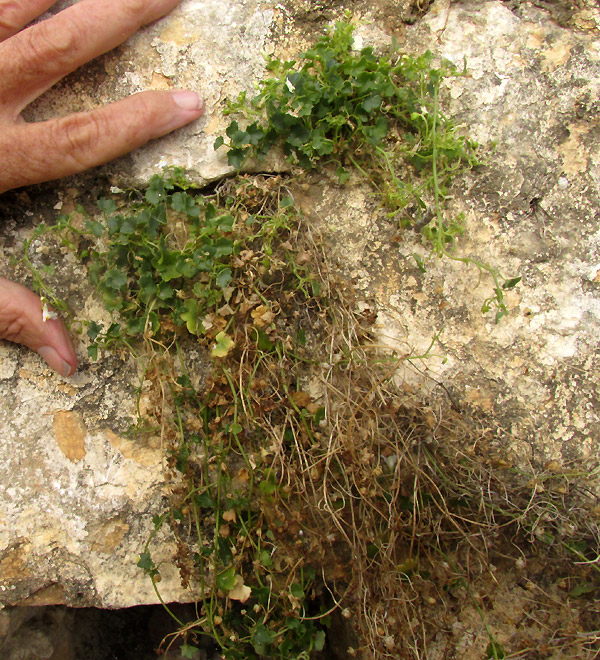
This individual's flowers, however, lacked any hint of blue:
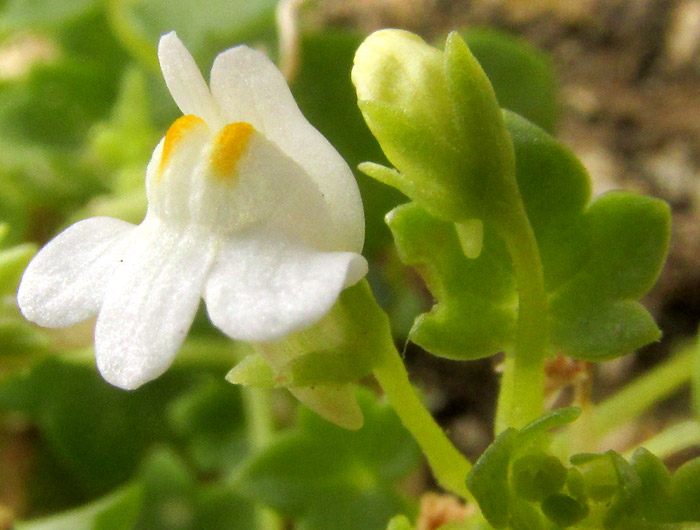
Also, the leaves were more succulent:
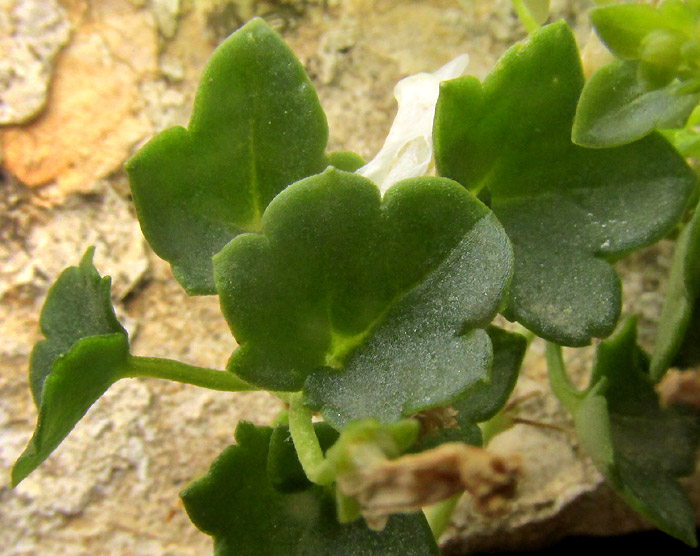
This time a fruit was approaching maturity. Fruits of the the genus Cymbalaria are described as being capsules splitting open by way of two three-toothed pores at the tip, where numerous small seeds are released, though I can't see that here:
